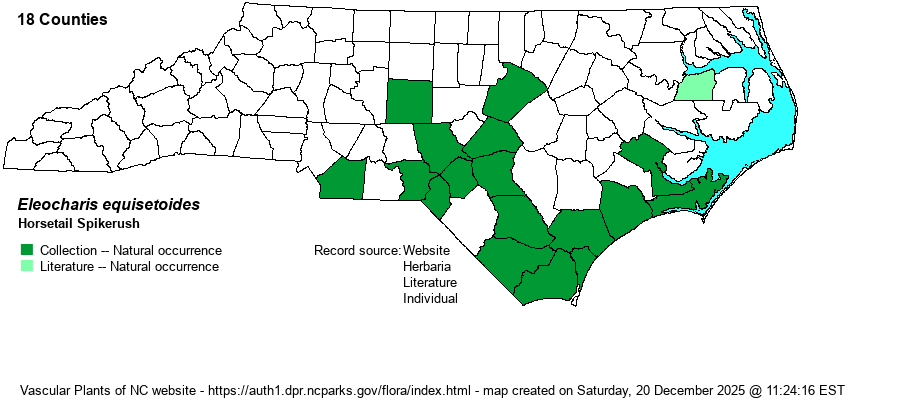| Author | (Elliott) Torrey | |
| Distribution | Lower Piedmont, Sandhills, and mainly the southern Coastal Plain. Largely absent from the northern Coastal Plain.
MA to southern Ont. and WI, south to FL and TX; disjunct in CA. | |
| Abundance | Uncommon to infrequent. Very rare in the northern Coastal Plain. However, plants are usually common or abundant where found. This is a Watch List species, but this designation could perhaps be dropped as this species appears to be secure in NC. | |
| Habitat | Shallow water of ponds, lake margins, reservoirs, quarry pools, borrow pits. | |
| Phenology | Flowering and fruiting June-September. | |
| Identification | Along with E. quadrangulata, this is our most robust spikerush, normally 2-3 feet tall. It differs from that species in its rounded stem in cross-section (vs. 4-sided). It differs from E. cellulosa by its size and cross-septate stems (vs. non-septate). | |
| Taxonomic Comments | None
The genus Eleocharis, the spikerushes, are unusual members of the sedge family in that the culms (flowering stems) are round or oval (rarely triangular) in cross-section, rather than triangular in the great majority of our sedges. In addition, leaf blades are absent; just 1-2 basal sheaths are present at the base of the culm. There is a single, cylindrical or narrowly ovoid, spikelet of florets at the culm summit. Details of achene (seed) shape, color, ornamentation, bristle length, and beak (tubercle) shape and size, are critical ID factors. | |
| Other Common Name(s) | Jointed Spikesedge | |
| State Rank | S3 | |
| Global Rank | G4 | |
| State Status | W1 | |
| US Status | | |
| USACE-agcp | OBL link |
| USACE-emp | OBL link |

